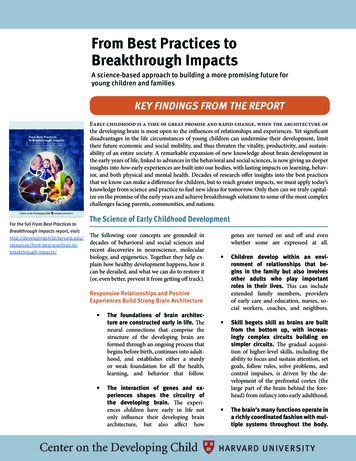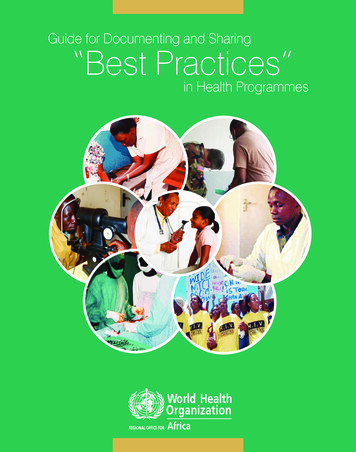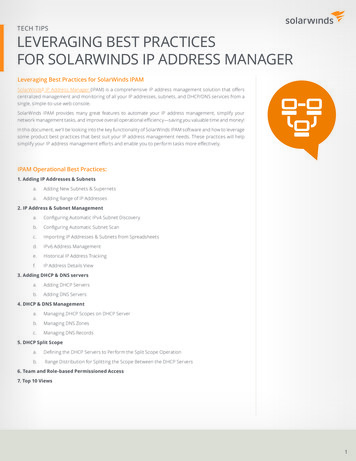
Transcription
From Best Practices toBreakthrough ImpactsA science-based approach to building a more promising future foryoung children and familiesKEY FINDINGS FROM THE REPORTFrom Best Practicesto Breakthrough ImpactsA science-based approach to building a morepromising future for young children and familiesFor the full From Best Practices toBreakthrough Impacts report, /from-best-practices-tobreakthrough-impacts/Early childhood is a time of great promise and rapid change, when the architecture ofthe developing brain is most open to the influences of relationships and experiences. Yet significantdisadvantages in the life circumstances of young children can undermine their development, limittheir future economic and social mobility, and thus threaten the vitality, productivity, and sustainability of an entire society. A remarkable expansion of new knowledge about brain development inthe early years of life, linked to advances in the behavioral and social sciences, is now giving us deeperinsights into how early experiences are built into our bodies, with lasting impacts on learning, behavior, and both physical and mental health. Decades of research offer insights into the best practicesthat we know can make a difference for children, but to reach greater impacts, we must apply today’sknowledge from science and practice to fuel new ideas for tomorrow. Only then can we truly capitalize on the promise of the early years and achieve breakthrough solutions to some of the most complexchallenges facing parents, communities, and nations.The Science of Early Childhood DevelopmentThe following core concepts are grounded indecades of behavioral and social sciences andrecent discoveries in neuroscience, molecularbiology, and epigenetics. Together they help explain how healthy development happens, how itcan be derailed, and what we can do to restore it(or, even better, prevent it from getting off track).genes are turned on and off and evenwhether some are expressed at all. Children develop within an environment of relationships that begins in the family but also involvesother adults who play importantroles in their lives. This can includeextended family members, providersof early care and education, nurses, social workers, coaches, and neighbors. Skill begets skill as brains are builtfrom the bottom up, with increasingly complex circuits building onsimpler circuits. The gradual acquisition of higher-level skills, including theability to focus and sustain attention, setgoals, follow rules, solve problems, andcontrol impulses, is driven by the development of the prefrontal cortex (thelarge part of the brain behind the forehead) from infancy into early adulthood. The brain’s many functions operate ina richly coordinated fashion with multiple systems throughout the body.Responsive Relationships and PositiveExperiences Build Strong Brain Architecture The foundations of brain architecture are constructed early in life. Theneural connections that comprise thestructure of the developing brain areformed through an ongoing process thatbegins before birth, continues into adulthood, and establishes either a sturdyor weak foundation for all the health,learning, and behavior that follow. The interaction of genes and experiences shapes the circuitry ofthe developing brain. The experiences children have early in life notonly influence their developing brainarchitecture, but also affect how
KEY FINDINGSCognitive, emotional, and social capacities are highlyinterrelated, and the circuitry that affects learning andbehavior is interconnected with physiological systemsthat affect physical and mental health.Protective Factors in the Early Years StrengthenResilience Providing the right ingredients for healthy development from the start produces better outcomesthan trying to fix problems later. Scientists use theterm “plasticity” to refer to the capacity of the brain tolearn from experience, which is greatest early in life anddecreases with age. Although windows of opportunityremain open for many years, trying to change behavior or build new skills on a foundation of brain circuitsthat were not wired properly from the beginning requires more effort— for both individuals and society. Positive early experiences, support from adults,and the development of adaptive skills cancounterbalance the lifelong consequences ofadversity. Children who have overcome hardships almost always have had at least one stableand responsive relationship with a parent, caregiver, or other adult who provided vital support and helped them build effective coping skills. Both children and adults need a set of core capabilities to respond to or avoid adversity, and thesecapacities can be strengthened through coachingand practice. Self-regulation helps us to draw on theright skills at the right time, respond effectively to theworld around us, and resist inappropriate responses.Executive function includes the ability to focus andsustain attention, set goals, follow rules, solve problems, and delay gratification. Overcoming the effectsof adversity on the development and use of these capabilities requires attention to both reducing sources ofsignificant stress and actively building skills.Adversity Disrupts the Foundations of Learning,Behavior, and Health Toxic stress responses can impair development,with lifelong consequences. Learning how to copewith adversity is an important part of healthy childdevelopment, and short-lived activation of a youngchild’s stress response systems helps build adaptive responses while supportive relationships help restore thephysiological reactions to baseline. If buffering protection from a caring adult is not available and stressresponses are extreme and long-lasting, excessive activation can have a toxic effect on developing brainarchitecture and other maturing biological systems.Any child who experiences prolonged adversity isat risk for physical and mental health problems,and individuals who are more vulnerable to stressare even more likely to experience long-term impacts. Early exposure to child abuse or neglect, family turmoil, neighborhood violence, extreme poverty,racial discrimination, or other hardships can primebiological systems to become hyper-responsive toadversity. Stress-inducing experiences such as theseearly in life, particularly for children who are genetically more vulnerable to adverse environments, areassociated with increased risk of lifelong physical andmental health problems, including major depression,addictions, heart disease, and diabetes.Lessons Learned from Five Decades of Program Evaluation ResearchThe current early childhood landscape includes a diverse array of policies and services designed to strengthen families’ability to support the healthy development of their children.These include Head Start/Early Head Start, primary healthcare, preschool, child care, home visiting, food assistance, financial supports, and services for children with special needs.Fifty years of program evaluation have produced extensive evidence of positive impacts overall, yet limited data on scalable“best programs.” Nevertheless, it is possible to identify fivekey characteristics that have been associated consistently withpositive outcomes across a range of ages and interventions.2 Center on the Developing Child at Harvard UniversityBuild Caregiver SkillsAdults who care for young children—whether theyare parents, relatives, friends, or staff in early childhood programs—need both capabilities and knowledge tosupport healthy child development. Caregivers who strugglewith the serious, daily stresses of low-wage jobs, communityor family violence, and/or chaotic home environments oftenrequire additional support and opportunities to strengthenthe skills that are essential for providing the stability and responsiveness that young children need.WWW.DEVELOPINGCHILD.HARVARD.EDU
KEY FINDINGSHome-visiting services that support parents, professionaldevelopment for teachers and caregivers, and efforts to engageparents in center-based, child-focused programs are all mosteffective when they actively and intensively help adults acquireand practice capabilities that are linked to explicit child outcomes. Adequate compensation is critical for recruiting andretaining a skilled early childhood workforce that is preparedto meet the needs of both children and parents.Match Interventions to Sources of SignificantStressThe ultimate strategy for preventing the negative effects of stress on the largest number of people would be toreduce poverty, violence, discrimination, and other threatsto child well-being as a societal goal. When interventions areimplemented at the individual level, greater impacts are morelikely when services focus on explicit needs, promote warmand responsive caregiving, and strengthen the ability of parents and other adults to scaffold the development of youngchildren’s adaptive capabilities. Research shows that: Interventions that promote “serve and return” interactions and offer individualized coaching that increasesparents’ awareness of their child’s behaviors can prevent or reduce abuse and neglect. Policies and programs that alleviate poverty may havethe greatest impact on child development when thechildren are youngest. Intensive and early intervention for children withspecial needs can improve their skills, school achievement, and long-term independence. For parents and other caregivers with mental healthproblems, clinical services and support programs aremost likely to help the children if they treat both theadult and the child in the context of their relationship. Because excessive parental intake of alcohol or moodaltering drugs and recurrent domestic violence can beextremely detrimental to child development, the limited data on intergenerational interventions should bea clarion call for more effective approaches.Support the Health and Nutrition of Children andMothers Before, During, and After PregnancyThe foundations of lifelong health begin with thewell-being of the future mother before she becomes pregnant.Preventive health care for pregnant women and their youngchildren is essential for supporting physical, emotional, andcognitive development. Programs that help meet children’searly nutritional needs also promote healthy brain development and overall well-being. Although recent expansions inhealth insurance coverage in the United States have improvedaccess to medical services, persistent racial, ethnic, and socioeconomic disparities in low birth weight, infant mortality,3Center on the Developing Child at Harvard Universityand many chronic diseases remain a serious challenge. Manythought leaders point to pediatric primary care as the mostappropriate point of entry for a universally available, prevention-oriented system of services—a role that is not currentlybeing filled successfully by most primary care settings andwould benefit from fresh thinking. Even more important isthe need for more effective, preventive interventions at thecommunity level to reduce stress-inducing burdens on families (i.e., the social determinants of health), which are beyondthe capacity of the medical care system alone to address.Improve the Quality of the Broader CaregivingEnvironmentWhether home- or center-based, non-parental carethat features well-documented effectiveness factors can generate a range of positive life outcomes for young children.These factors include language-rich environments that provide warm and responsive, serve-and-return interactions insafe physical settings with small group sizes and high ratios ofadults to children. Because young children from economicallyinsecure families experience greater variation in child carequality, increasing their access to high-quality care is clearlyneeded.Establish Clear Goals and Appropriately TargetedCurriculaPrograms for young children are most effective whenthey implement an age-appropriate curriculum that providesengaging activities designed to achieve clearly defined goals.However, when successful services are not described precisely,they are difficult to replicate and impossible to scale. In contrast, when an explicit theory of change is articulated and services are well-defined, pre-identified impacts are more likelyto be achievable, replicable, and scalable.Best Practice as a Starting Point, Not the DestinationThe five core principles of effective programs described abovecan guide continuous improvement in the quality of a widearray of policies and programs that have evolved in the UnitedStates over the past half-century. The well-documented impactsof flagship programs include higher educational attainment,fewer unplanned pregnancies, increased economic productivity, and reduced criminal behavior. Nevertheless, the qualityof implementation when programs are replicated continues tobe variable, and the magnitude of impacts achieved by scaledup programs has remained small to moderate.We can and must do better. This is particularly true for children in the first three years after birth and for families whoseneeds are not being met by existing policies and services.Determining the appropriate mix of strategies to capitalizeon strengths and address needs is one of the most compellingchallenges facing the early childhood field.WWW.DEVELOPINGCHILD.HARVARD.EDU
KEY FINDINGSFilling the Missing NicheDeliveringstate-of-the-artMeetingstandardsThe R&D PlatformAdopting & adaptingthe most promisingnew strategiesGenerating &testing newideas acrosssectorsBasic capabilityissues that mustbe addressedSOURCE: CENTER ON THE DEVELOPING CHILD (2016), ADAPTED FROMEVERETT ROGERS, DIFFUSION OF INNOVATIONS (2003).Creating an R&D Engine to Produce Breakthrough Impacts at ScaleSuccessful leaders in other fields (e.g., technology, medicine,and business) all maintain a comparative advantage by investing in research & development (R&D). That same mindset must be incorporated into the design and testing of newstrategies to address the challenges facing young children andtheir families—from early learning and primary health care topublic health, child welfare, poverty reduction, mental health,community development, and criminal justice. The time hascome to build a dynamic R&D platform to catalyze a new erain early childhood policy and practice—driven by a new wayof thinking fueled by advances in science and a new way ofworking that embraces the culture of innovation.Well-established scientific knowledge suggests three fundamental shifts in the thinking that informs most currentpolicies and programs focused on young children: Early experiences affect lifelong physical and mentalhealth, not just learning. Healthy brain development requires protection fromexcessive stress, not just enrichment in a stimulatingenvironment. Achieving breakthrough outcomes for children experiencing significant adversity requires that we supportthe adults who care for them to transform their ownlives.Substantially greater impact at a population level, however,requires more than new ideas—we must also change the way4 Center on the Developing Child at Harvard Universitywe design, test, evaluate, and scale promising strategies. Webelieve this requires the following components:Co-Creation in Designing and Testing New ProgramStrategies. Actively combining knowledge and experiencefrom science, practice, community, and policy perspectivesis essential to innovative thinking. Productive collaborationbrings together people who seek novel ideas to address identified gaps and challenges with partners who develop creativeapproaches to achieve specified outcomes. When these rolesconverge in teams and settings that have the mindset, skills,leadership, and flexible funding to design and test new strategies, the conditions are in place for breakthrough impact.Precision in Intervention Definition and Measurement.Achieving population-level impact depends upon the abilityto learn what works (and doesn’t) for whom, when, in whatcontext(s)—and why. This degree of specificity requires a precise theory of change, well-defined intervention materials tiedto explicitly defined target domains, and an evaluation planthat drives the rigorous measurement of those domains, theunderlying core capacities that are expected to change, and alimited number of important outcomes. The ultimate value ofthis approach is demonstrated by how much is learned aboutthe intervention’s impacts, not by whether sufficient evidenceis produced to prove it was effective on average.WWW.DEVELOPINGCHILD.HARVARD.EDU
KEY FINDINGSA Rapid-Cycle, Iterative Process for Improving Programs.A nimble process of continuous learning from small-scalefeasibility studies and pilot testing of promising, new interventions with small numbers of children and families provides valuable opportunities to explore causal pathways andtest program effects across varied contexts, target groups,dosages, and modifications—all with less upfront fundingand a shorter timeframe for producing results.A Strategy for Identifying Who Benefits Most (and Least).The transition from successful demonstration projects topopulation-level impacts requires significant attention to theheterogeneity of populations being served and the inevitablevariability in their response to interventions. When programdevelopers and system leaders can match effective strategiesto relevant client characteristics, they can better serve children and families that are most likely to benefit while drivingthe development of new approaches for those who do not.An “Active Ingredients” Approach to Cost-EffectiveScaling. When program evaluators ask “does it work?” ratherthan “which features work for whom and why?” the onlypathway to scaling is to replicate every aspect of the program.A more efficient and cost-effective approach would selectivelyscale the active ingredients of an effective intervention withinexisting programs or service infrastructures.Innovation that Extends Beyond Programs and intoSystems. Science-based R&D can also be driven by decisionmakers in a multitude of systems that set explicit priorities,establish incentives and reduce barriers to innovation, andserve children and families at a population level. Creativeleaders in a diversity of venues can play important roles indeveloping and sustaining R&D at a systems level by adoptingthe principles described above and providing the funding andregulatory flexibility needed to support risk-taking and learnfrom both successes and failures.A Call to ActionA highly energized R&D dimension is an essential part ofany healthy, sustainable enterprise. Its absence in the earlychildhood field threatens the future of all communities inwhich the challenges facing children and families are not beingfully met by existing policies and programs. Building one willrequire an active and diverse community of change agents incommunity, policy, program, system, research, education, andphilanthropic settings. The central question before us is notwhether strategic risk-taking and fresh thinking are importantprerequisites to breakthrough impacts. The more compellingquestions are: How can we make that happen? What will ittake to reduce the barriers and provide incentives? How canwe come together across multiple sectors to learn from bothfailure and success? The possibility for substantial progress inour ability to dramatically improve the life prospects of youngchildren is real. The time to aim higher is now.The Center on the Developing Child’s mission is to drive science-based innovation that achievesbreakthrough outcomes for children facing adversity. We believe that advances in science provide apowerful source of new ideas focused on the early years of life. Founded in 2006, the Center catalyzeslocal, national, and international innovation in policy and practice focused on children and families. Wedesign, test, and implement these ideas in collaboration with a broad network of research, practice, policy,community, and philanthropic leaders. Together, we seek transformational impacts on lifelong learning,behavior, and both physical and mental health. Learn more at www.developingchild.harvard.edu.5 Center on the Developing Child at Harvard UniversityWWW.DEVELOPINGCHILD.HARVARD.EDU
From Best Practices to Breakthrough Impacts KEY FINDINGS FROM THE REPORT The following core concepts are grounded in decades of behavioral and social sciences and recent discoveries in neuroscience, molecular biology, and epigenetics. Together they help ex-plain how healthy development happens, how it can be derailed, and what we can do to .










